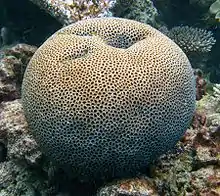Tammes problem
In geometry, the Tammes problem is a problem in packing a given number of circles on the surface of a sphere such that the minimum distance between circles is maximized. It is named after a Dutch botanist who posed the problem in 1930 while studying the distribution of pores on pollen grains. It can be viewed as a particular special case of the generalized Thomson problem.

Some natural systems such as this coral require approximate solutions to problems similar to the Tammes problem
Bibliography
- Journal articles
- Tammes PML (1930). "On the origin of number and arrangement of the places of exit on pollen grains". Diss. Groningen.
- Tarnai T; Gáspár Zs (1987). "Multi-symmetric close packings of equal spheres on the spherical surface". Acta Crystallographica. A43: 612–616. doi:10.1107/S0108767387098842.
- Erber T, Hockney GM (1991). "Equilibrium configurations of N equal charges on a sphere" (PDF). Journal of Physics A: Mathematical and General. 24: Ll369–Ll377. Bibcode:1991JPhA...24L1369E. doi:10.1088/0305-4470/24/23/008.
- Melissen JBM (1998). "How Different Can Colours Be? Maximum Separation of Points on a Spherical Octant". Proceedings of the Royal Society A. 454 (1973): 1499–1508. Bibcode:1998RSPSA.454.1499M. doi:10.1098/rspa.1998.0218.
- Bruinsma RF, Gelbart WM, Reguera D, Rudnick J, Zandi R (2003). "Viral Self-Assembly as a Thermodynamic Process" (PDF). Physical Review Letters. 90 (24): 248101–1–248101–4. arXiv:cond-mat/0211390. Bibcode:2003PhRvL..90x8101B. doi:10.1103/PhysRevLett.90.248101. Archived from the original (PDF) on 2007-09-15.
- Books
- Aste T, Weaire DL (2000). The Pursuit of Perfect Packing. Taylor and Francis. pp. 108–110. ISBN 978-0-7503-0648-5.
- Wells D (1991). The Penguin Dictionary of Curious and Interesting Geometry. New York: Penguin Books. pp. 31. ISBN 0-14-011813-6.
External links
This article is issued from Wikipedia. The text is licensed under Creative Commons - Attribution - Sharealike. Additional terms may apply for the media files.